2. 土壤与农业可持续发展国家重点实验室(中国科学院南京土壤研究所), 南京 210008;
3. 湖南省土壤肥料研究所, 长沙 410125;
4. 河海大学农业工程学院, 南京 210098;
5. 湖南省水稻研究所, 长沙 410125
2. State Key Laboratory of Soil and Sustainable Agriculture, Nanjing Institute of Soil Science, Chinese Academy of Sciences, Nanjing 210008, China;
3. Hunan Soil and Fertilizer Institute, Changsha 410125, China;
4. College of Agricultural Engineering, Hohai University, Nanjing 210098, China;
5. Hunan Rice Research Institute, Changsha 410125, China
水稻是我国三大粮食作物之一,我国水稻种植面积占全国总粮食作物的1/4[1]。稻油轮作是我国南方水稻土的主要种植制度之一。近年来,水稻油菜免耕直播的种植模式迅速发展。有研究表明,稻油轮作连续免耕有利于提高作物产量和改善稻田表层土壤肥力[2-3],实施稻油轮作免耕直播模式对保护生态环境和农业可持续发展具有重要意义。
土壤结构影响着土壤水、气运动、根系生长以及土壤生物的活动[4]。合理的耕作是创造适宜作物生长的土壤结构的主要措施之一[5]。免耕在改善旱地土壤结构、增加土壤生物多样性等方面已取得显著效果[6],然而免耕对水稻土结构的影响尚不清楚。黄国勤等[7]研究表明稻田实施保护性耕作后土壤容重降低,水稻产量显著提高。Gao等[8]发现稻油轮作系统下免耕提高了0~10 cm土层土壤大团聚体含量,促进了有机碳在土壤表层的积累。而杭玉浩等[9]则发现长期免耕导致表层土壤容重增加、耕层变浅、土壤结构变差。这些差异可能是由于土壤质地[10]、不同免耕年限[11]、轮作系统[12]和管理方式[13]等的差异造成的。
应用X射线计算机断层(CT)扫描技术可以非破坏性地研究土壤内部结构[14-15],获取土壤三维孔隙形态参数,并进行三维结构的可视化[16]。本研究基于洞庭湖区耕作试验,利用X射线CT扫描等技术,研究免耕对稻油轮作系统水稻土结构的影响,研究结果为该区域选择合理的耕作方式提供参考。
1 材料与方法 1.1 试验区概况试验田位于湖南省益阳市南县三仙湖镇太平桥村(112°24′E,29°09′N)。试验区属亚热带季风性湿润气候,年平均气温16.6 ℃,年均降水量1 238 mm。土壤类型为湖积物发育的底潜简育水耕人为土,试验开始前0~20 cm土层土壤基本理化性质见表 1。试验田长期水稻(6月上旬至10月中旬)-油菜(10月下旬至5月中旬)轮作,耕作方式最初为旋耕,自2013年开始实行水稻和油菜两季免耕。本试验于2016年开始,在实施了3年的免耕基础上设置免耕和旋耕两个处理,采用大区设计,面积为900 m2(30 m × 30 m)。其中免耕处理两季均开沟分厢,一厢一沟,厢面宽1.8 m,沟的尺寸为宽30 cm ×深15 cm。旋耕处理油菜季开沟分厢,厢面宽1.5 m,沟的尺寸同免耕处理,水稻季不开沟。
供试水稻品种为深两优5814,油菜品种为华湘油16。免耕处理水稻及油菜均人工撒播,旋耕处理的水稻和油菜分别采用抛秧和人工移栽。各处理水稻季施肥量均为尿素90 kg·hm-2,复合肥(N:P2O5:K2O=17%:5%:26%)720 kg·hm-2,撒施;油菜季施肥量均为尿素195 kg·hm-2,复合肥300 kg·hm-2,穴施。水稻季免耕处理尿素于3~4叶期一次性施用,复合肥于5~6叶期施用5/6,1/6用作穗肥;旋耕处理水稻抛秧前5/6复合肥作基肥,7~10叶期追施尿素,1/6复合肥作穗肥。油菜季免耕处理1/5尿素拌种作促苗肥,4叶1心期追施4/5尿素,6叶1心期追施复合肥,以保证冬发壮苗;旋耕处理复合肥全部作基肥施入,9~10叶期尿素全部作追肥施入。
|
|
表 1 供试土壤基本理化性质 Table 1 Basic physical and chemical properties of the studied soil |
于2018年5月水稻播种前采集土壤样品,每个大区内采用五点取样法,用PVC环刀(高5 cm、内径4.8 cm)采集5个层次(0~5 cm,5~10 cm,10~15 cm,15~20 cm,20~25 cm)的原状土柱,用保鲜膜包裹防止水分蒸发。同时采集5个层次的混合土壤样品,每个大区内按S形线路采集9个点,混合后放入塑料盒中带回实验室。原状土柱饱和48 h后置于压力膜仪中,保持-33 kPa,平衡后取出进行CT扫描。混合土壤样品自然风干,在风干过程中将土样掰成小于10 mm的小块。风干土样一部分用于土壤团聚体分析,一部分过2 mm或0.15 mm筛用于土壤理化性质测定。
1.3 CT扫描与图像处理利用X射线显微CT(Phenix Nanotom S,GE,USA)扫描原状土柱,扫描电压为110 kV,电流为110 µA,曝光时间为1.25 s,分辨率为25 µm。将样品固定于样品台上,从0到360°匀速旋转,在此过程中采集1 200幅投影图像。利用Datosx2|Rec软件进行图像重建,重建后生成2 100幅2 284×2 304体元的8位灰度图像,存储为tif格式。利用ImageJ软件进行图像预处理,包括增加对比度和中值滤波。为了避免采样过程对样品边界的影响,选取样品中间部分的1 200×1 200×1 200体元作为感兴趣区域进行图像分析。采用Default阈值分割法[17]对图像进行分割得到二值图像,孔隙度利用Volume Fraction插件计算,孔隙大小分布利用Thickness插件计算。
1.4 土壤容重、有机碳含量、团聚体分布及稳定性CT扫描后的样品于105℃下烘干24 h至恒重,测定土壤容重。土壤有机碳含量采用重铬酸钾氧化—外加热法测定[18]。团聚体的稳定性采用Le Bissonnias快速湿润法[19]。首先将3~5 mm团聚体置于40℃烘箱烘干24 h,然后称取5 g烘干后的团聚体,放入装有50 mL去离子水的100 mL烧杯中浸泡10 min,之后用移液管移去烧杯中的水,将团聚体转移至浸没在酒精中的筛子(孔径为50 µm),将筛子向左右各转动3圈,然后将筛子中的土用酒精小心洗入铝盒并于40 ℃烘箱中烘干48 h。烘干后土样置于套筛(孔径依次为3、2、1、0.5、0.25和0.05 mm)上筛分,并将每一级筛子上土样称重记录,根据以下公式计算平均质量直径(Mean weight diameter,MWD)
| $ {\rm{MWD}} = \sum\limits_{i = 1}^n {\frac{{{{\rm{r}}_{i - 1}} + {{\rm{r}}_i}}}{2}} {{\rm{m}}_i} $ |
式中,n为筛子的个数,ri为第i个筛子的孔径(mm),mi为第i个筛子上的团聚体质量百分比(%)。
1.5 统计分析方法采用RStudio 1.1.456对实验数据进行统计分析。团聚体稳定性和孔隙大小分布等指标的同一土层不同处理间的方差分析采用t.test(数据符合正态分布)和wilcox.test(数据不符合正态分布),土壤有机碳和土壤大孔隙度的同一处理不同个土层间的方差分析采用one-way ANOVA,数据的正态性检验采用Shapiro-Wilk test,方差齐性检验采用leveneTest,并用TukeyHSD进行多重比较,显著性水平为0.05。
2 结果与讨论 2.1 耕作方式对水稻土容重及有机碳的影响免耕和旋耕处理下土壤容重如图 1所示。免耕处理的土壤容重随着土壤深度的增加而增大,且0~25 cm各土层间均存在显著性差异(P < 0.05)。旋耕处理0~15 cm各土层间土壤容重均无显著差异,但在15~20 cm土层时容重显著增大,这是由于耕作形成的犁底层所致。与旋耕相比,免耕处理0~5 cm土层的土壤容重降低了5.1%,但两处理间未达到显著性差异;10~15 cm土层免耕显著高于旋耕处理(P < 0.05),其他土层两处理间无显著差异。Denardin等[20]通过对免耕14年的稻田研究发现,免耕处理显著降低了表层土壤容重,对5~20 cm土层作用不显著。冯跃华等[21]研究也表明,免耕两年后稻田0~5 cm土层容重较翻耕处理降低了3.55%,与本研究结果一致,由于免耕处理未受到机械的扰动,前茬秸秆残留物易堆积在土壤表层,经土壤动物及微生物作用,从而降低了表层土壤的容重。10~15 cm土层土壤容重免耕高于旋耕处理,其原因是旋耕扰动了耕层土壤,导致容重低于免耕处理。
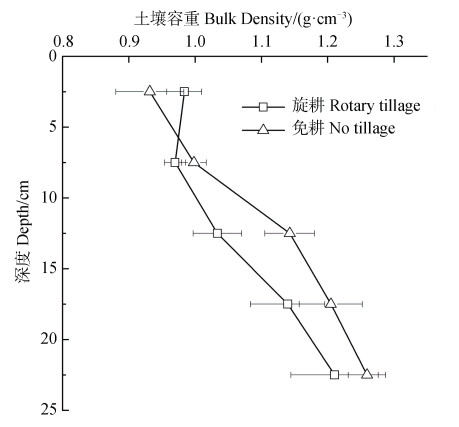
|
图 1 不同耕作方式对不同土层的土壤容重的影响 Fig. 1 Effects of tillage on soil bulk density relative to tillage method and soil layer |
图 2为不同耕作方式下不同土层的土壤有机碳含量。旋耕与免耕处理表层土壤有机碳含量均较高,分别为34.3 g·kg-1和34.4 g·kg-1。随着深度的增加,土壤有机碳含量逐渐降低。除表层外,其他土层免耕处理的有机碳含量均显著低于旋耕处理(P < 0.05)。结果表明稻油轮作区免耕处理未提高土壤有机碳含量。许多研究表明免耕能够提高土壤有机碳的含量[7, 22],与本研究结果不一致。张锡洲等[11]研究发现土壤有机碳的含量与免耕年限有关,随着免耕年限的增加,土壤有机质含量逐渐增加。为了更加准确地评价不同耕作方式对土壤结构的影响,今后仍需开展土壤有机碳的动态研究。
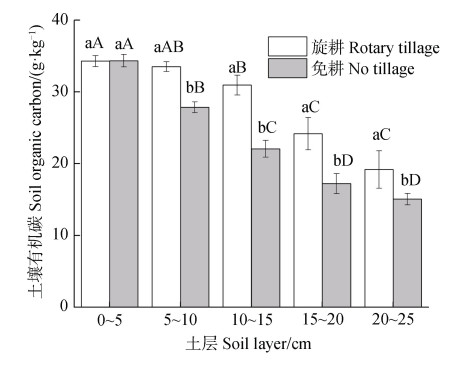
|
注:大写字母表示相同处理不同土层间的差异显著性(P < 0.05),小写字母表示相同土层不同处理间的差异显著性(P < 0.05),下同。Note:Upper case letters indicate significant differences between different soil layers under the same tillage mode(P < 0.05),and lower case letters indicate significant differences between different tillage modes in the same soil layer(P < 0.05),the same below. 图 2 不同耕作方式对不同土层土壤有机碳含量的影响 Fig. 2 Effects of tillage on soil organic carbon content relative to tillage method and soil layer |
不同耕作方式对0~25 cm土层土壤团聚体大小分布的影响如表 2所示。随着土层深度的增加,旋耕和免耕两个处理 > 2 mm的大团聚体含量降低,0.25~0.053和 < 0.053 mm的微团聚体含量增加。0~20 cm土层均以 > 2 mm的大团聚体居多,特别是在0~5和5~10 cm,旋耕处理 > 2 mm团聚体含量分别为72.0%、64.0%,免耕处理分别为87.0%、77.0%。与旋耕处理相比,免耕处理提高了0~20 cm土层 > 2 mm粒级土壤团聚体的含量,尤其是在0~5和5~10 cm土层,免耕较旋耕处理分别提高了19.8%、19.4%,达到了显著性水平(P < 0.05)。不同处理土壤团聚体的平均质量直径(MWD)随着土层深度的增加逐渐降低(表 2)。与旋耕相比,免耕处理显著提高了0~5 cm和5~10 cm土层团聚体的MWD,提高幅度分别为14.6%和14.1%(P < 0.05),表明免耕处理能显著提高0~10 cm土层大团聚体含量以及土壤团聚体的稳定性,这与唐晓红等[23]和王志强等[12]研究结果一致。稻田免耕减少了土壤的耕作次数,也就减少了对土壤结构的破坏,有利于形成稳定的土壤结构,促使微团聚体向大团聚体团聚[22]。此外,由于未受到人为扰动,免耕可以促进土壤表层的生物活性[24],土壤动物的丰富度和数量增加,有助于在大团聚体内部结合形成微团聚体,增加其结构稳定性。而耕作扰动破坏土壤结构,降低团聚体稳定性[9]。
|
|
表 2 不同耕作措施对不同土层水稳性团聚体分布和稳定性的影响 Table 2 Effects of tillage on water stable aggregate size distribution relative to tillage mode and soil layer |
图 3为不同处理各个土层的二维灰度图像(30×30 mm)和三维孔隙结构图像(30×30×30 mm)。本研究的图像获取的孔隙均为大于图像分辨率(25 μm)的孔隙。从灰度图中可以看到,两个处理0~10 cm土层孔隙较大,数量多;10 cm以下土层的孔隙相对较少,随深度的增加,孔隙数量减少。三维图像显示,旋耕和免耕处理在0~5和5~10 cm土层孔隙结构更为复杂。与0~10 cm土层相比,两个处理在10~15 cm土层土壤孔隙明显减少;在15~25 cm土层的孔隙以根孔为主。
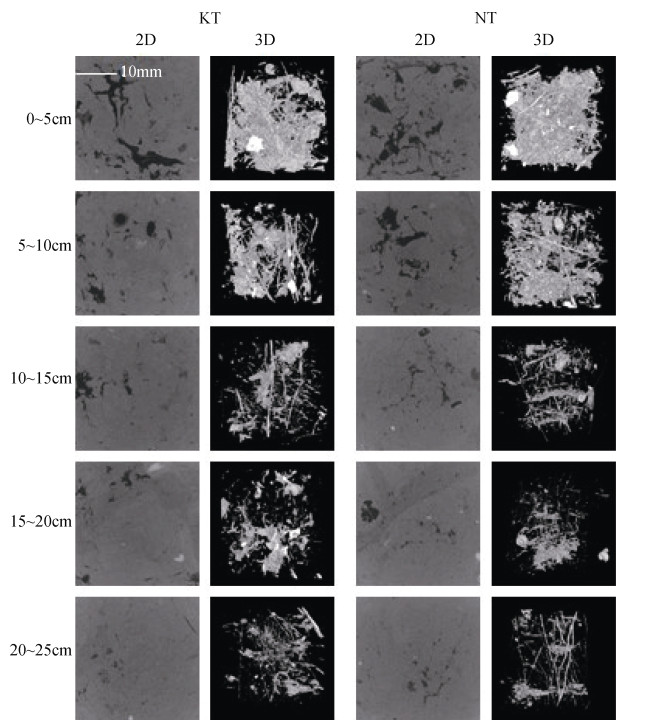
|
注:RT表示旋耕,NT表示免耕;二维灰度图中浅色部分为土壤基质,深色部分为土壤孔隙。Note:RT stands for rotary tillage,NT for no tillage. The light-colored part of the two-dimensional grayscale image indicates soil matrix,and the dark part,soil pores. 图 3 不同耕作措施对不同土层水稻土二维(30×30 mm)和三维结构(30×30×30 mm)的影响 Fig. 3 Effects of tillage on 2D(30×30 mm)and 3D(30×30×30 mm)structure of paddy soil relative to tillage method and soil layer |
定量分析结果表明,旋耕和免耕处理土壤大孔隙度(> 25 μm)均随着土层深度的增加而降低(图 4)。在0~5和5~10 cm土层免耕处理的土壤大孔隙度均显著高于旋耕处理(P < 0.05),分别提高了78%和115%;10~25 cm间各个土层两处理土壤大孔隙度均没有显著差异。有研究发现免耕处理下土壤表层蚯蚓较翻耕多[25],蚯蚓在某一土层数量的多少取决于土层中可食性有机碎屑的多少以及根系的数量和类型[26]。免耕由于不受机械扰动,枯枝落叶大量等有机物料聚集在土壤表层增加了表层土壤的动物种群数量,土壤动物通过生物扰动增加了土壤大孔隙度。
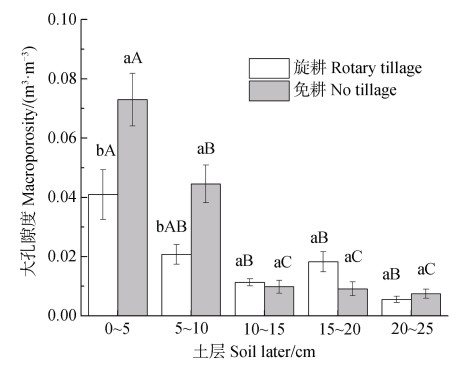
|
图 4 不同耕作方式对不同土层土壤大孔隙度的影响 Fig. 4 Effects of tillage on soil macroporosity relative to tillage method and soil layer |
从土壤大孔隙分布图(图 5)可以看出,0~25 cm间各土层均以25~300 μm孔径的大孔隙居多,且随着孔径的增大,大孔隙度逐渐降低。与旋耕相比,免耕处理增加了0~5和5~10 cm土层各个孔径范围内的大孔隙度,0~5 cm土层300~500 μm孔径的大孔隙增加了70.5%,5~10 cm土层25~300和300~500 μm孔径的大孔隙分别增加了82.8%和167.2%,均达到了显著性差异水平。不同土层 > 2 000 μm的土壤大孔隙在不同处理间差异很大,免耕处理 > 2 000 μm大孔隙主要存在于0~5和5~10 cm土层,大孔隙度分别为1.10×10-2 m3·m-3、1.20×10-3 m3·m-3,而旋耕处理 > 2 000 μm孔径的大孔隙在0~5、5~10、10~15和15~20 cm土层均有分布,孔隙度分别为3.60×10-3 m3·m-3、1.00×10-3 m3·m-3、4.00×10-4 m3·m-3、1.30×10-3 m3·m-3。旋耕与免耕处理10 cm土层以下各个孔径的大孔隙度没有显著性差异(15~20 cm土层500~1000 μm孔径除外)。总体而言,免耕提高了0~10 cm土层各个孔径的大孔隙,从而使0~10 cm土层具有更好的孔隙系统。免耕可以保持土壤结构,使土壤动物(蚯蚓)和前茬作物根系形成的大孔隙不受破坏,构成了上下连通的体系[27]。Gao等[28]通过对旱地沙壤土的研究表明,免耕影响了土壤孔隙大小分布,增加了大孔隙的数量,具有更多连接的孔隙;郭亚飞[29]对黑土的研究也表明,免耕具有更好的土壤孔隙结构。本研究结果还显示,免耕显著提高了0~10 cm土层300~500 µm孔径的大孔隙度,这与许多旱地研究结果一致。Kay和VandenBygaart [30]指出,与传统耕作相比,免耕增加了100~500 μm的大孔隙,随着免耕年限的增加,> 500 μm的生物性孔隙也增加。陈学文等[31]研究也表明在大豆-玉米轮作下免耕秸秆还田增加了0~5 cm土层 > 100 μm的大孔隙,其原因为免耕土壤表层秸秆和根茬增加了有机质含量,形成了通气孔隙良好的团粒结构。但本研究免耕处理下并没有提高土壤有机碳含量,因而土壤大孔隙系统的改善主要归因于免耕后土壤动物的活动和未受到耕作的扰动。
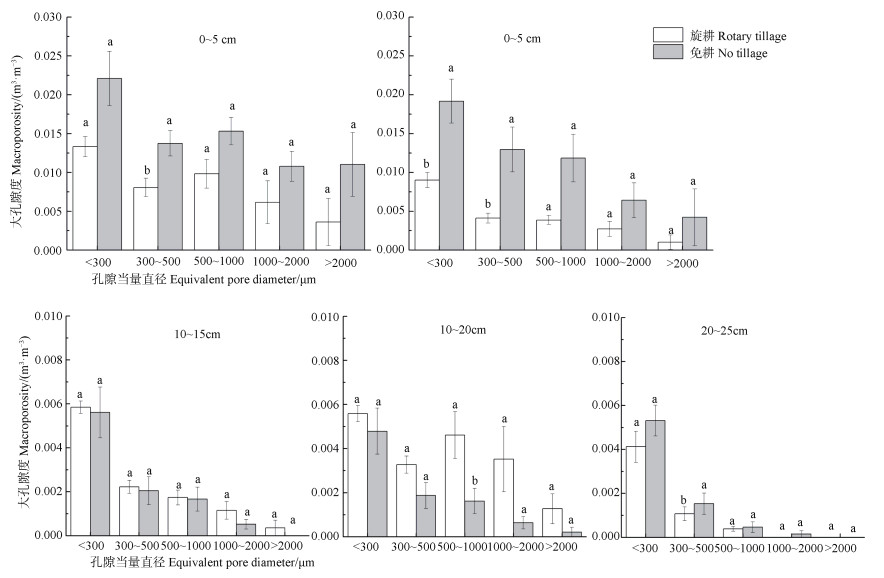
|
图 5 不同耕作方式对不同土层土壤孔隙大小分布的影响 Fig. 5 Effects of tillage on pore size distribution relative to tillage method and soil layer |
通过洞庭湖区4a稻油轮作系统的耕作试验对土壤物理结构的研究表明,免耕虽然未显著改变0~5 cm土层土壤有机碳含量和土壤容重,但显著提高了0~10 cm土层土壤大孔隙度和团聚体的水稳性;此外,免耕改变了土壤孔隙大小分布,显著提高了0~10 cm土层各个孔径的大孔隙,显著提高了0~10 cm土层300~500 µm以及5~10 cm土层25~300 µm孔径的大孔隙度。总体而言,免耕使0~10 cm土层具有更好土壤孔隙系统,改善了水稻土表层土壤结构,这对在农业生产实践中制定合理的耕作方式提供了一定的理论依据。
| [1] |
Liu Z H, Li Z G, Tang P Q, et al. Spatial-temporal changes of rice area and production in China during 1980-2010 (In Chinese)[J]. Acta Geographica Sinica, 2013, 68(5): 680-693. [刘珍环, 李正国, 唐鹏钦, 等. 近30年中国水稻种植区域与产量时空变化分析[J]. 地理学报, 2013, 68(5): 680-693.]
(  0) 0) |
| [2] |
Cui X Q, Ruan Z, Liu D, et al. Effects of tillage methods on physicochemical properties and heavy metal availability of soils in rice-rape rotation systems (In Chinese)[J]. Journal of Soil and Water Conservation, 2012, 26(5): 73-77. [崔孝强, 阮震, 刘丹, 等. 耕作方式对稻-油轮作系统土壤理化性质及重金属有效性的影响[J]. 水土保持学报, 2012, 26(5): 73-77.]
(  0) 0) |
| [3] |
Du X B, Luo L J, Chen C, et al. Effects of long-term No-tillage direct seeding mode on crop yield and soil physiochemical properties in rice/rapeseed rotation system (In Chinese)[J]. Chinese Journal of Rice Science, 2013, 27(6): 617-623. DOI:10.3969/j.issn.1001-7216.2013.06.008 [杜兴彬, 罗利军, 陈晨, 等. 稻-油轮作连续免耕直播对作物产量及土壤理化性状的影响[J]. 中国水稻科学, 2013, 27(6): 617-623.]
(  0) 0) |
| [4] |
Bronick C J, Lal R. Soil structure and management:A review[J]. Geoderma, 2005, 124(1/2): 3-22.
(  0) 0) |
| [5] |
Li Y J, Wang H, Zhao J N, et al. Effects of tillage methods on soil physicochemical properties and biological characteristics in farmland:A review (In Chinese)[J]. Chinese Journal of Applied Ecology, 2015, 26(3): 939-948. [李玉洁, 王慧, 赵建宁, 等. 耕作方式对农田土壤理化因子和生物学特性的影响[J]. 应用生态学报, 2015, 26(3): 939-948.]
(  0) 0) |
| [6] |
Yang X M, Zhang X P, Fang H J, et al. Conservation tillage systems in North America and their significance for China (In Chinese)[J]. Chinese Journal of Applied Ecology, 2004, 15(2): 335-340. DOI:10.3321/j.issn:1001-9332.2004.02.035 [杨学明, 张晓平, 方华军, 等. 北美保护性耕作及对中国的意义[J]. 应用生态学报, 2004, 15(2): 335-340.]
(  0) 0) |
| [7] |
Huang G Q, Yang B J, Wang S B, et al. Effects of 8 years of conservational tillage on rice yield and soil physical, chemical and biological properties (In Chinese)[J]. Acta Ecologica Sinica, 2015, 35(4): 1225-1234. [黄国勤, 杨滨娟, 王淑彬, 等. 稻田实行保护性耕作对水稻产量、土壤理化及生物学性状的影响[J]. 生态学报, 2015, 35(4): 1225-1234.]
(  0) 0) |
| [8] |
Gao M, Luo Y J, Wang Z F, et al. Effect of tillage system on distribution of aggregates and organic carbon in a hydragric anthrosol[J]. Pedosphere, 2008, 18(5): 574-581. DOI:10.1016/S1002-0160(08)60051-X
(  0) 0) |
| [9] |
Hang Y H, Wang Q S, Xu G C, et al. Ecological response of nutrient properties of paddy field to different tillage practices (In Chinese)[J]. Chinese Agricultural Science Bulletin, 2017, 33(10): 106-112. DOI:10.11924/j.issn.1000-6850.casb16050149 [杭玉浩, 王强盛, 许国春, 等. 稻田土壤养分特性对不同耕作方式的生态响应[J]. 中国农学通报, 2017, 33(10): 106-112.]
(  0) 0) |
| [10] |
Gong D Q, Lu J. Effects of continuous no-tillage on physicochemical properties of paddy soils with different textures (In Chinese)[J]. Acta Ecologica Sinica, 2014, 34(2): 239-246. [龚冬琴, 吕军. 连续免耕对不同质地稻田土壤理化性质的影响[J]. 生态学报, 2014, 34(2): 239-246.]
(  0) 0) |
| [11] |
Zhang X Z, Li T X, Yu H Y, et al. Effects of long-term natural no-tillage on soil physiochemical properties in rice/wheat rotation systems (In Chinese)[J]. Journal of Soil and Water Conservation, 2006, 20(6): 145-147. DOI:10.3321/j.issn:1009-2242.2006.06.035 [张锡洲, 李廷轩, 余海英, 等. 水旱轮作条件下长期自然免耕对土壤理化性质的影响[J]. 水土保持学报, 2006, 20(6): 145-147.]
(  0) 0) |
| [12] |
Wang Z Q, Liu Y, Yang W T, et al. Effects of rotation and fallow in paddy field on distribution and stability of soil aggregates (In Chinese)[J]. Acta Pedologica Sinica, 2018, 55(5): 1143-1155. [王志强, 刘英, 杨文亭, 等. 稻田复种轮作休耕对土壤团聚体分布及稳定性的影响[J]. 土壤学报, 2018, 55(5): 1143-1155.]
(  0) 0) |
| [13] |
Xue B, Huang L, Lu J W, et al. Effects of continuous straw returning and No-tillage on soil aggregates and organic carbon (In Chinese)[J]. Journal of Soil and Water Conservation, 2018, 32(1): 182-189. [薛斌, 黄丽, 鲁剑巍, 等. 连续秸秆还田和免耕对土壤团聚体及有机碳的影响[J]. 水土保持学报, 2018, 32(1): 182-189.]
(  0) 0) |
| [14] |
Zhou H, Li W Z, Zhang Z B, et al. Characterization of multi-scale soil structure with X-ray computed tomography (In Chinese)[J]. Acta Pedologica Sinica, 2013, 50(6): 1226-1230. [周虎, 李文昭, 张中彬, 等. 利用X射线CT研究多尺度土壤结构[J]. 土壤学报, 2013, 50(6): 1226-1230.]
(  0) 0) |
| [15] |
Zhou H, Fang H, Mooney S J, et al. Effects of long-term inorganic and organic fertilizations on the soil micro and macro structures of rice paddies[J]. Geoderma, 2016, 266: 66-74. DOI:10.1016/j.geoderma.2015.12.007
(  0) 0) |
| [16] |
dal Ferro N, Charrier P, Morari F. Dual-scale micro-CT assessment of soil structure in a long-term fertilization experiment[J]. Geoderma, 2013, 204/205: 84-93. DOI:10.1016/j.geoderma.2013.04.012
(  0) 0) |
| [17] |
Ridler TW, Calvard S. Picture thresholding using an iterative selection method[J]. IEEE Transactions on Systems, Man, and Cybernetics, 1978, 8(8): 630-632. DOI:10.1109/TSMC.1978.4310039
(  0) 0) |
| [18] |
Bao S D. Soil and agricultural chemistry analysis (In Chinese). Beijing: China Agriculture Press, 2000. [鲍士旦. 土壤农化分析[M]. 北京: 中国农业出版社, 2000.]
(  0) 0) |
| [19] |
Le Bissonnais Y. Aggregate stability and assessment of soil crustability and erodibility:I. Theory and methodology[J]. European Journal of Soil Science, 2016, 67(1): 11-21. DOI:10.1111/ejss.4_12311
(  0) 0) |
| [20] |
Denardin L G O, Carmona F C, Veloso M G, et al. No-tillage increases irrigated rice yield through soil quality improvement along time[J]. Soil and Tillage Research, 2019, 186: 64-69. DOI:10.1016/j.still.2018.10.006
(  0) 0) |
| [21] |
Feng Y H, Zou Y B, Roland J B, et al. Effects of no-tillage and direct broadcasting on soil physical and chemical properties and growth and growth and yield formation in hybrid rice (In Chinese)[J]. Acta Agronomica Sinica, 2006, 32(11): 1728-1736. DOI:10.3321/j.issn:0496-3490.2006.11.022 [冯跃华, 邹应斌, Roland J B, 等. 免耕直播对一季晚稻田土壤特性和杂交水稻生长及产量形成的影响[J]. 作物学报, 2006, 32(11): 1728-1736.]
(  0) 0) |
| [22] |
Jiang Z P, Huang S M, Wei G P, et al. Effects of different no-tillage modes on rice yield and properties of paddy soil (In Chinese)[J]. Chinese Agricultural Science Bulletin, 2007(12): 362-365. DOI:10.3969/j.issn.1000-6850.2007.12.078 [江泽普, 黄绍民, 韦广泼, 等. 不同免耕模式对水稻产量及土壤理化性状的影响[J]. 中国农学通报, 2007(12): 362-365.]
(  0) 0) |
| [23] |
Tang X H, Wei C F, Lü J G, et al. Effects of conservation tillage on aggregate stability of paddy soil in hilly region (In Chinese)[J]. Transactions of the CSAE, 2009, 25(11): 49-54. DOI:10.3969/j.issn.1002-6819.2009.11.010 [唐晓红, 魏朝富, 吕家恪, 等. 保护性耕作对丘陵区水稻土团聚体稳定性的影响[J]. 农业工程学报, 2009, 25(11): 49-54.]
(  0) 0) |
| [24] |
Wang Q Q, Wang S L. Formation and stability mechanism of soil aggregate and influencing factors (In Chinese)[J]. Chinese Journal of Soil Science, 2005, 36(3): 415-421. DOI:10.3321/j.issn:0564-3945.2005.03.031 [王清奎, 汪思龙. 土壤团聚体形成与稳定机制及影响因素[J]. 土壤通报, 2005, 36(3): 415-421.]
(  0) 0) |
| [25] |
Johnsonmaynard J, Umiker K, Guy S. Earthworm dynamics and soil physical properties in the first three years of no-till management[J]. Soil and Tillage Research, 2007, 94(2): 338-345. DOI:10.1016/j.still.2006.08.011
(  0) 0) |
| [26] |
Asare S N, Rudra R P, Dickinson W T, et al. SW-Soil and water:Soil macroporosity distribution and trends in a No-till plot using a volume computer tomography scanner[J]. Journal of Agricultural Engineering Research, 2001, 78(4): 437-447. DOI:10.1006/jaer.2000.0659
(  0) 0) |
| [27] |
Gao M, Zhang L, Wei C F, et al. Study of the changes of the rice yield and soil fertility on the paddy field under long-term no-tillage and ridge culture conditions (In Chinese)[J]. Plant Nutrition and Fertilizing Science, 2004, 10(4): 343-348, 354. DOI:10.3321/j.issn:1008-505X.2004.04.002 [高明, 张磊, 魏朝富, 等. 稻田长期垄作免耕对水稻产量及土壤肥力的影响研究[J]. 植物营养与肥料学报, 2004, 10(4): 343-348, 354.]
(  0) 0) |
| [28] |
Gao L L, Becker E, Liang G P, et al. Effect of different tillage systems on aggregate structure and inner distribution of organic carbon[J]. Geoderma, 2017, 288: 97-104. DOI:10.1016/j.geoderma.2016.11.005
(  0) 0) |
| [29] |
郭亚飞.保护性耕作下蚯蚓在土壤结构形成和有机碳周转过程中的作用[D].北京: 中国科学院大学, 2018. Guo Y F. Impacts of earthworm on soil structure formation and soil organic carbon turnover under conservation tillage[D]. Beijing: University of Chinese Academy of Sciences, 2018. (  0) 0) |
| [30] |
Kay B, VandenBygaart A. Conservation tillage and depth stratification of porosity and soil organic matter[J]. Soil and Tillage Research, 2002, 66(2): 107-118. DOI:10.1016/S0167-1987(02)00019-3
(  0) 0) |
| [31] |
Chen X W, Zhang X P, Liang A Z, et al. Tillage effects on soil pore size distribution and soil moisture in Northeast China (In Chinese)[J]. Journal of Arid Land Resources and Environment, 2012, 26(6): 114-120. [陈学文, 张晓平, 梁爱珍, 等. 耕作方式对黑土耕层孔隙分布和水分特征的影响[J]. 干旱区资源与环境, 2012, 26(6): 114-120.]
(  0) 0) |
 2021, Vol. 58
2021, Vol. 58


